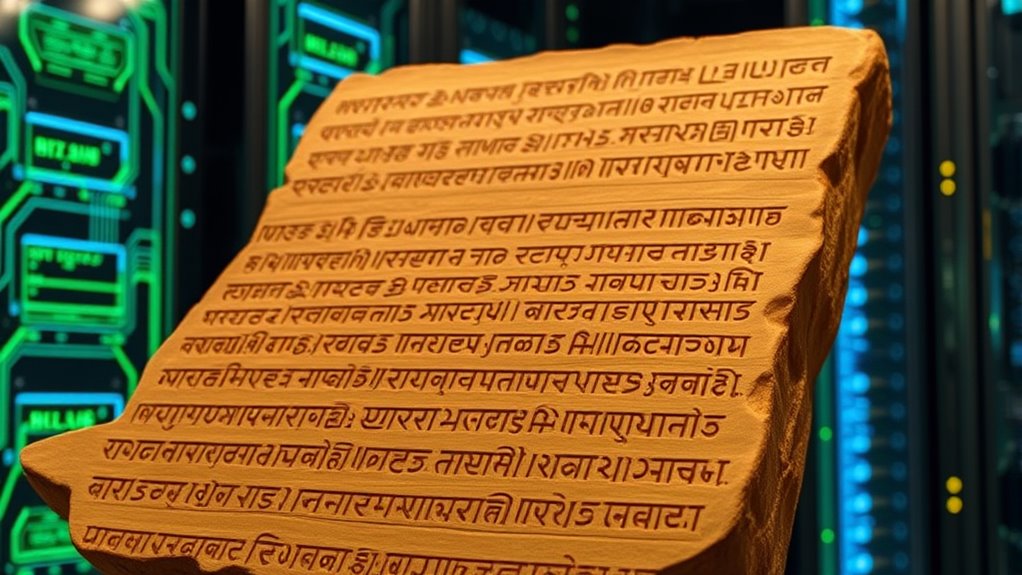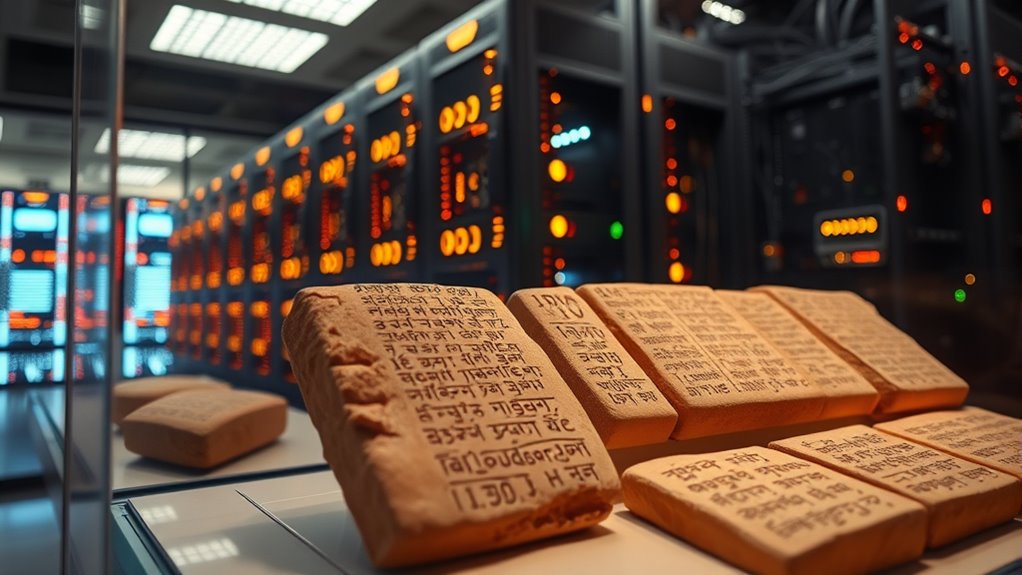Your journey through the epic quest for pi reveals a fascinating evolution from ancient civilizations like Babylonians and Egyptians, who used rough geometrical methods, to Greeks like Archimedes, who refined the approach with polygons. Then, with calculus, mathematicians developed infinite series, enabling more digits. Modern supercomputers now calculate trillions of digits with advanced algorithms, showcasing technological progress. If you keep exploring, you’ll uncover even more about how humanity’s curiosity continues to push the boundaries of understanding pi.
Key Takeaways
- Early civilizations like Babylonians and Egyptians made rough approximations of pi, initiating the long quest for precision.
- Greek mathematicians, especially Archimedes, developed polygon methods to refine pi estimates significantly.
- The advent of calculus introduced infinite series, enabling more accurate and systematic calculations of pi.
- Computational tools and algorithms in the modern era exponentially increased the number of pi digits that could be computed.
- Today, supercomputers and advanced algorithms continue pushing the boundaries of pi’s decimal expansion, showcasing technological progress.

Have you ever wondered how mathematicians set out on their epic quest to understand pi? It’s a journey that spans thousands of years, rooted in curiosity and driven by the desire to uncover the secrets of this mysterious constant. To appreciate how far we’ve come, you need to explore the rich mathematical history that tracks the evolution of ideas about pi and the computational techniques that have advanced over time. Early civilizations, like the Babylonians and Egyptians, recognized that the ratio of a circle’s circumference to its diameter was a special number, but their methods for estimating pi were imprecise by today’s standards. The Babylonians, for instance, approximated pi as 3.125, using simple geometric methods and basic calculations. Over centuries, mathematicians refined these estimates, developing more sophisticated techniques to improve accuracy.
As mathematical understanding deepened, so did the methods used to calculate pi. The Greeks, especially Archimedes, pioneered a major breakthrough by inscribing and circumscribing polygons around circles. He calculated the perimeters of these polygons, which provided upper and lower bounds for pi. By increasing the number of sides in the polygons, he could tighten these bounds, inching closer to the true value. This approach was revolutionary because it laid the groundwork for the use of inscribed and circumscribed figures as a means of approximation. Moving forward, mathematicians began exploring infinite series—powerful computational techniques that could generate increasingly accurate digits of pi. The advent of calculus in the 17th century allowed for the development of formulas like the Gregory-Leibniz series, which expresses pi as an infinite sum. While slow to converge, these series marked a significant step toward precise calculations, highlighting how computational techniques evolved to harness the power of infinite processes. Additionally, the challenge of calculating digits with greater precision spurred the development of early computational tools, which laid the foundation for modern algorithms.
The quest for more digits also transformed with the advent of computers. During the 20th century, the development of algorithms—systematic procedures for calculations—revolutionized the process. The use of computer algorithms, like the fast Fourier transform and iterative methods, enabled mathematicians to compute billions of digits of pi in record time. These computational techniques harnessed the raw power of machines, pushing the boundaries of how many digits could be calculated and tested. Today, supercomputers and advanced algorithms continue to refine our understanding, not just of pi’s digits but also of its properties. Your journey through the mathematical history and computational techniques reveals a story of relentless curiosity, innovation, and technological progress—an ongoing quest that unites ancient insights with modern computing power.
Frequently Asked Questions
How Does Pi Relate to Quantum Computing Advancements?
You might wonder how pi relates to quantum computing advancements. Quantum algorithms leverage superposition states to perform complex calculations more efficiently, and pi often appears in these algorithms’ mathematical foundations. By exploiting superposition, quantum computers can simulate intricate problems involving pi, such as quantum Fourier transforms. This connection helps improve the precision and speed of computations, pushing forward the capabilities of quantum technology and deepening our understanding of fundamental constants like pi.
What Are the Latest Breakthroughs in Calculating Pi?
You’re diving headfirst into the latest breakthroughs in calculating pi, and it’s clear progress is speeding up. Researchers use advanced computational algorithms that push beyond traditional methods, achieving unprecedented precision. Recent efforts build on historical approximation techniques while leveraging modern hardware, like quantum processors. These innovations are like hitting two birds with one stone, bringing us closer to understanding pi’s endless digits and revealing new scientific possibilities.
Can Pi Be Exactly Represented in Any Number System?
You might wonder if pi can be exactly represented in any number system. In most number systems, pi can’t be expressed exactly because it’s an irrational number. You rely on rational approximations, which are close but never perfect. Only rational numbers can be precisely represented in standard number systems, so pi always remains an approximation, no matter which system you use.
How Does Pi Influence Modern Technology Beyond Mathematics?
Imagine the history of irrationality as a thread weaving through modern tech. Pi, with its endless digits, symbolizes this, influencing everything from GPS accuracy to medical imaging. Its cultural significance reminds us how math shapes our world. You rely on it daily—whether in smartphones or digital cameras—showing that beyond pure math, pi’s legacy drives technological innovation, connecting history and future in seamless harmony.
Are There Practical Applications for Extremely Precise Pi Values?
You might wonder if extremely precise values of pi matter practically. In reality, mathematical constants like pi are essential for high-precision calculations, especially in fields like aerospace, cryptography, and scientific simulations. Computational precision guarantees that tiny errors don’t accumulate, which is critical for accurate results. While everyday use doesn’t need such accuracy, advanced technology relies on these precise pi values to maintain reliability and safety in complex systems.
Conclusion
You’ve traveled through time, tackling tangent trials from ancient Babylonians to brilliant modern supercomputers. This relentless, riveting quest reveals how humanity’s hunger for harmony and precision keeps pushing boundaries. As you continue your own journey, remember that the pursuit of pi is more than a mathematical measure—it’s a magnificent mirror of mankind’s curiosity, creativity, and ceaseless craving for discovery. Keep chasing the circle, and let your curiosity conquer the cosmos!









